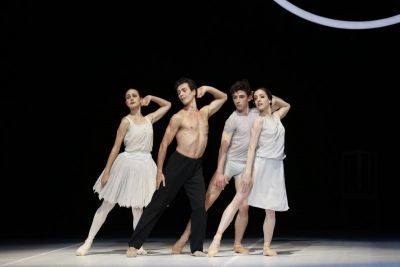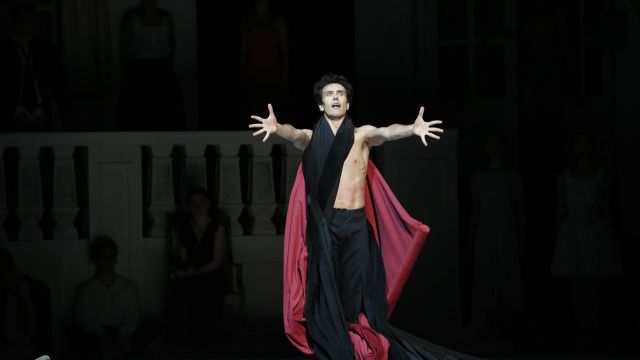Nijinksy
There cannot be any lover of ballet who doesn’t know the name of Nijinsky - the first great male dancer in the Ballet world, a tragic genius who changed the world of dance as we know it. Without Vaslav Nijinsky there would have been no Nureyev, no Barishnikov, no Vasiliev and certainly no Merce Cunningham … and Ballet would have remained dominated by ballerinas.
Neumeier’s extraordinary work is part drama, part biography and an amazing meld of contemporary and classical dance. The contemporary, with bent back toes and leg positions apposite to the long extensions and pointed toes of the classical genre, serve to amplify how far ahead of his time Nijinsky was, how outside the norm was his style. He could dance brilliantly in the accepted style of the day, but so often he chose not to - he pushed his own boundaries to the point where we might now see him as the father of contemporary dance. Neumeier realises this brilliantly in his choreography and, though we have rarely seen the two styles juxtaposed so closely, he captures for us the uniqueness that must have been Nijinsky. This work is the closest we can come, since there is no film of Nijinsky’s work, only tales of his astonishing elevation, his ethereal fragility and strength.
The choice of music is quite beautiful throughout: selections from Chopin, Schumann, and most of Rimsky-Korsakov’s exquisite Scheherazade form Act one, while Shostakovich gives voice to Vaslav’s madness in Act Two.

Diagnosed as schizophrenic, and spending much of his later life in asylums, Nijinsky’s story begins with his last performance in a hotel ballroom in St Moritz (1919) and ends with the mental disintegration of Vaslav during World War 1. But this storytelling isn’t a simple flashback to events. In this choreographer’s hands it is a portal to Vaslav’s mind; a mixture of fantasy and fact, of confusion and clarity.
It should not be seen in any way as a slight to Kevin Jackson, a marvellous dancer, that he did not dance the role of Vaslav on opening night. Instead Neumeier chose to bring out his principal danseur from The Hamburg Ballet, Alexandre Riabko, a dancer very familiar with the role, to play Vaslav. The physicality would certainly be a factor in the decision. Riabko is slight, a quite tiny dancer but with astonishing strength. He has incredible vulnerability and to see him cradled in the arms of the much larger Diaghilev – brilliantly realised by Adam Bull – is one of the most poignant moments in the ballet. Not without tenderness, Diaghilev nevertheless handles Vaslav, his lover, like putty - a thing to be moulded, to be owned, to be shaped to his will. Neumeier’s storytelling in this area is quite breath-taking. Jackson is physically imposing, and much less likely to be convincing as a fragile child.
The choreographer uses different Nijinskys in different roles: the wonderfully lyrical Brett Simon as Petrouchka; the stylistically brilliant Cristiano Martino as The Golden Slave and the Faun; the impressive Chengwu Guo as The Spirit of the Rose and Harlequin in Carnaval. Christopher Rodgers Wilson is delightful in his small roles of Leonide Massine and the young man.
 Amy Harris impresses greatly with her acting as well as dance in the role of Nijinsky’s wife Romola, as does Leanne Stojmanov as Bronislava, Nijinksy’s sister, and Francois-Eloi Lavignac as brother Bronislav. Special bravas too for the delightful ballerina Ako Kondo, one of TAB’s rising stars.
Amy Harris impresses greatly with her acting as well as dance in the role of Nijinsky’s wife Romola, as does Leanne Stojmanov as Bronislava, Nijinksy’s sister, and Francois-Eloi Lavignac as brother Bronislav. Special bravas too for the delightful ballerina Ako Kondo, one of TAB’s rising stars.
Orchestra Victoria, under the direction of Nicolette Fraillon, is superb throughout, and the set, particularly the ballroom, is quite amazing. It’s hard to believe that Neumeier also designed it and it came from The National Ballet of Canada.
It is noticeable however, and has been for some time now, that the corps de ballet -particularly the male corps - has a big problem dancing in unison. Surely the precision of a corps is the backbone of a ballet company. And yet they seem incapable of an ensemble that can move as one – with leg and hand heights the same, and stylistically balanced. One dancer just a fraction of a move behind, or ahead, can pull focus from an entire scene. That notwithstanding, Nijinsky is a breathtaking and highly entertaining achievement that could perhaps have at least one of its multiple possible endings trimmed in the second act. A must see for all lovers of dance.
Coral Drouyn
Photographer: Jeff Busby
Subscribe to our E-Newsletter, buy our latest print edition or find a Performing Arts book at Book Nook.

